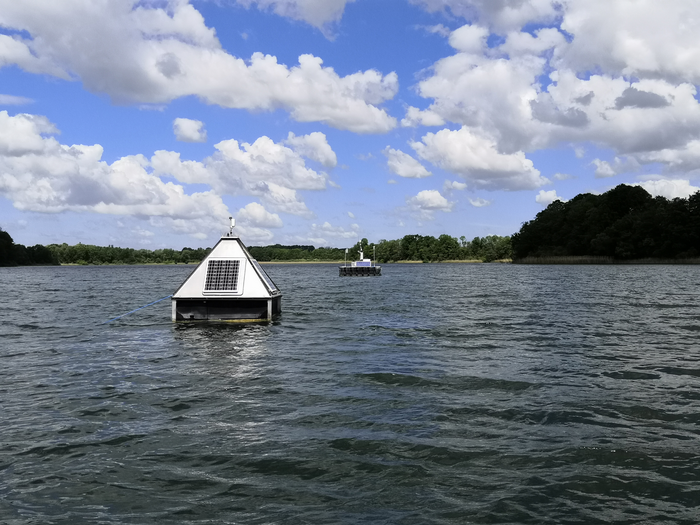In recent years, there have been increasing reports of toxic blue-green algae blooms in summer, even in German lakes, caused by climate warming and increased nutrient inputs. But humans have not only had an influence on the development of blue-green algae since modern times, but already since the Bronze Age from about 2,000 B.C. This is the result of a study by researchers from the German Research Centre for Geosciences GFZ and colleagues, published in the scientific journal Communications Biology. Since some blue-green algae, also known as cyanobacteria, leave no visible fossil traces in sediments due to their small size, little is known about how they evolved in our lakes during the last centuries and millennia. Using DNA from sediments, the researchers have now been able to decipher for the first time the history of blue-green algae over the last 11,000 years in the sediments of a lake in Mecklenburg, Germany.

Credit: A. Brauer
In recent years, there have been increasing reports of toxic blue-green algae blooms in summer, even in German lakes, caused by climate warming and increased nutrient inputs. But humans have not only had an influence on the development of blue-green algae since modern times, but already since the Bronze Age from about 2,000 B.C. This is the result of a study by researchers from the German Research Centre for Geosciences GFZ and colleagues, published in the scientific journal Communications Biology. Since some blue-green algae, also known as cyanobacteria, leave no visible fossil traces in sediments due to their small size, little is known about how they evolved in our lakes during the last centuries and millennia. Using DNA from sediments, the researchers have now been able to decipher for the first time the history of blue-green algae over the last 11,000 years in the sediments of a lake in Mecklenburg, Germany.
Background: Blue-green algae and their reproduction
Blue-green algae have proliferated in many bodies of water in recent decades. The causes are man-made: increasing nutrient inputs and global warming. Some blue-green algae species are toxic, so that mass blooms in bathing waters can even be hazardous to health. They can cause allergies if they come into contact with the skin or – in the case of small wounds – infections and – if they get into drinking water, for example – can even cause liver cancer in extreme cases.
Cyanobacteria, as blue-green algae are known, are among the oldest known organisms that carry out photosynthesis. Today’s land plants have ultimately inherited their ability to produce oxygen and fix carbon dioxide from cyanobacteria. Cyanobacteria also have another ability that distinguishes them from other algae. They can absorb nitrogen from the atmosphere and use it as a nutrient. This ability is one reason for the proliferation of blue-green algae at the expense of other aquatic organisms, which are increasingly being displaced.
DNA as the key to tracking blue-green algae
Unlike diatoms, for example, most blue-green algae do not leave fossil traces in the sediment to allow extensive taxonomic differentiation as distinct species. As a result, it is poorly known how blue-green algae in our lakes have evolved over several millennia.
“However, new methods now make it possible to detect DNA from various organisms in sediments, and this allows us to decipher the history of these cyanobacteria,” explains Ebuka Nwosu of the GFZ German Research Centre for Geosciences, lead author of the new study. The work, which involved other partners, was carried out as part of Ebuka Nwosu’s doctoral thesis funded by the German Federal Foundation for the Environment (DBU). It was supervised by Susanne Liebner, GFZ working group leader in the Geomicrobiology Section and professor at the University of Potsdam, and Achim Brauer, head of the GFZ Climate Dynamics and Landscape Development Section and professor at the University of Potsdam.
For this study, the researchers selected sediments from a lake in the Nossentiner-Schwinzer Heide Nature Park in Mecklenburg-Western Pomerania, Germany. “We know Lake Tiefer See very well and have dated its sediments very precisely because it has been part of the TERENO lake monitoring program at the German Research Center for Geosciences for many years,” says Achim Brauer, explaining the choice of this lake.
For the study, sedimentary cyanobacterial DNA was determined on an 11-meter sediment core, and then both the number and composition of blue-green algae species and their diversity were analyzed.
Evolution of blue-green algae over millennia: The particular influence of humans
In this way, the researchers were able to show that blue-green algae were already present in the oldest samples studied, 11,000 years ago, shortly after the lake was formed. However, the number and diversity of species were very low and blue-green algae probably did not play a special role in the lake’s ecosystem.
This did not change for many millennia. Only with the appearance of the first Bronze Age burial finds near the lake from around 2000 BC did the number and species communities of blue-green algae increase significantly. “This suggests that even early cultures had an impact on the nutrient balance of the lake through agricultural activities,” says Ebuka Nwosu.
Subsequently, the natural state prior to these initial changes was never regained. On the contrary, with each subsequent settlement phase, and preferentially during warmer climatic conditions, blue-green algae and their species communities continued to proliferate in Lake Tiefer See.
Since industrial agriculture started with greatly increased nitrogen inputs, this development has accelerated even more. “However, the conditions for these developments were created much earlier than we previously assumed,” Susanne Liebner emphasizes. And she adds that the nutrient-induced increase in blue-green algae will probably be further favored by the increasingly warmer summers in the future.
Journal
Communications Biology
DOI
10.1038/s42003-023-04430-z
Method of Research
Experimental study
Article Title
Early human impact on lake cyanobacteria revealed by a Holocene record of sedimentary ancient DNA.
Article Publication Date
18-Jan-2023




